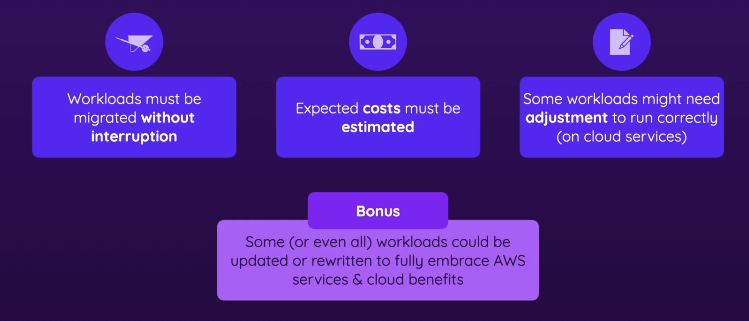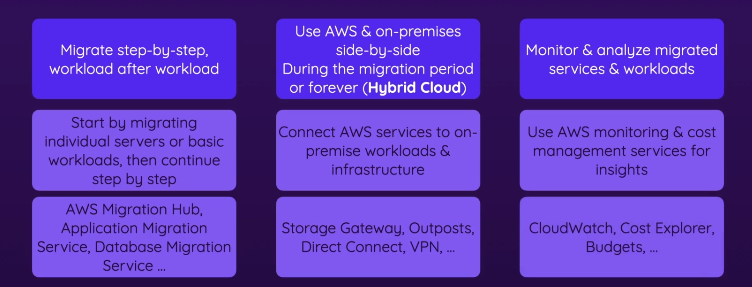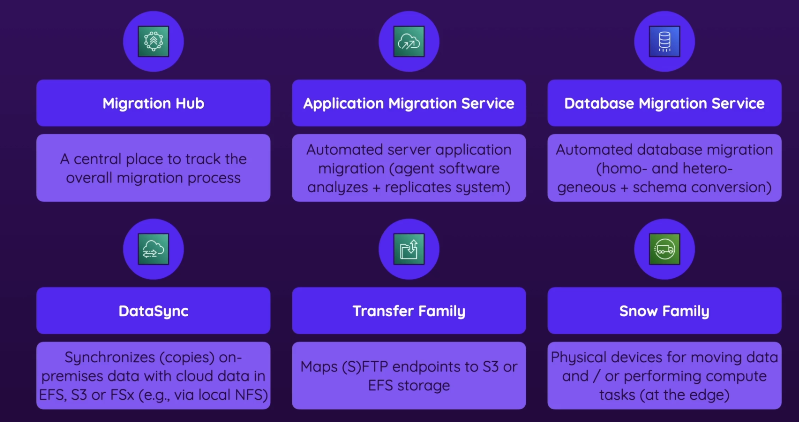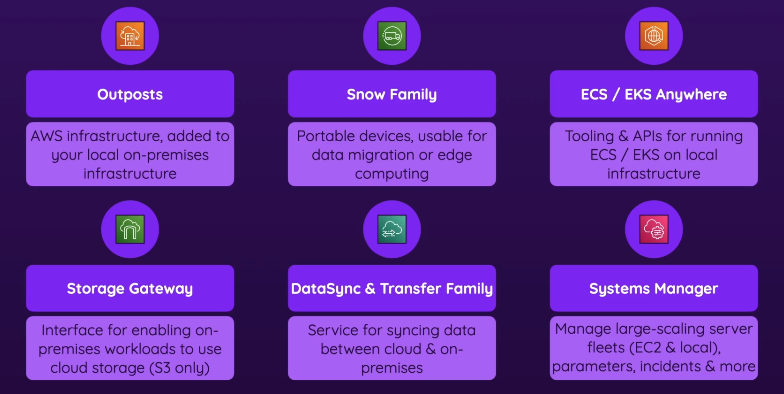Cloud
Most companies existed for a long time without cloud integration, so AWS helps with cloud migration / having a hybrid environment
- Key Migration services
- migration hub, application migration service, db migration service, datasync, transfer family, snow family
- Key Hybrid Cloud Computing Services
- outposts, snow family, ecs/eks anywhere, storage gateway, DataSync & transfer family, systems manager
- Example Scenario
- You have a company not in the cloud yet but has its own infrastructure where it runs its own workloads. This company may want to move to the cloud for cloud advantages
- All their applications must now run on cloud services
- Can be very complex
Challenges
- diagram

- Workloads must not be interrupted during migration
- Estimate the expected costs as soon as you have an idea of how your cloud infrastructure could look like
- Some workloads (code) may need adjustment to run correctly
- Bonus
- Some (or even all) workloads could be updated/rewritten to fully embrace AWS services and cloud benefits
- Ex) You can AWS SDK to communicate with those services
Solutions
- diagram

- Migrate step-by-step
- migrate individual servers or basic workloads, then continue step by step
- u can carefully test things
- AWS Migration Hub, Application Migration Service, Database Migration Service, etc
- Hybrid cloud
- Use AWS & On-premises side-by-side during the migration period (if you like this setup, u can stick to it forever too)
- You must connect AWS services to on-premise workloads & infrastructure
- Storage Gateway, outposts, direct connect, vpn, etc
- Monitor & analyze the migrated services & workloads
- AWS monitoring & cost management services
- CloudWatch, Cost explorer, budgets, etc
Key Migration Services
- diagram

Migration Hub
- Gives central place of tracking overall migration process
- make sure everything’s working as intended - gives visibility
Application Migration Service
- an automated server application migration
- replicates your local settings to the cloud (EC2 instances )
- u install a software (agent) on your local systems, it analyzes the environment → looks at the software, configs, the code, the OS, then replicates that automatically to the cloud
Database Migration Service
- Helps with migrating data from a local database to an AWS database
- able to do homo- and hetero- geneous migrations
- can convert db schemas if needed (can change structure)
DataSync
- Synchronizes (copies) data in your local data center into the cloud
- Able to connect with EFS, S3, or FSx there (and NOT EBS)
- Locally, use NFS to connect to those remote file systems/services
Transfer Family
- Allows to map (S)FTP endpoints to S3 or EFS
- Maybe your local servers use (S)FTP to upload files to local servers
Snow Family
- set of services
- Physical devices for moving data and/or performing compute tasks (at the edge)
- AWS ships to you → store data → send back to AWS → AWS move the data into the data center
- family
- Snowcone
- 2 sizes: 8TB (HHD)/14TB (SSD)
- Snowball Edge
- Storage Optimized (80TB) / Compute Optimized 39.5TB
- Snowmobile
- 100PB of storage
- Snowcone
- makes sense if you have too large amounts of data / bad connection / security reasons etc
- The services (discontinued.. https://aws.amazon.com/snowball/)
- AWS Snowcone
- AWS Snowball
- AWS Snowmobile
Key Hybrid Cloud Computing Services
- diagram

ECS/EKS Anywhere
Storage Gateway
- Allows you to extend cloud storage to cloud infrastructure
- Extending S3 to your local file system
Remaining
- Snow family (mentioned earlier)
- DataSync & Transfer family (mentioned earlier)
- Outposts
- Systems Manager (not limited to cloud infrastructure)
- if you download the systems manager agent on one of your local servers, you can also manage that server with systems manager